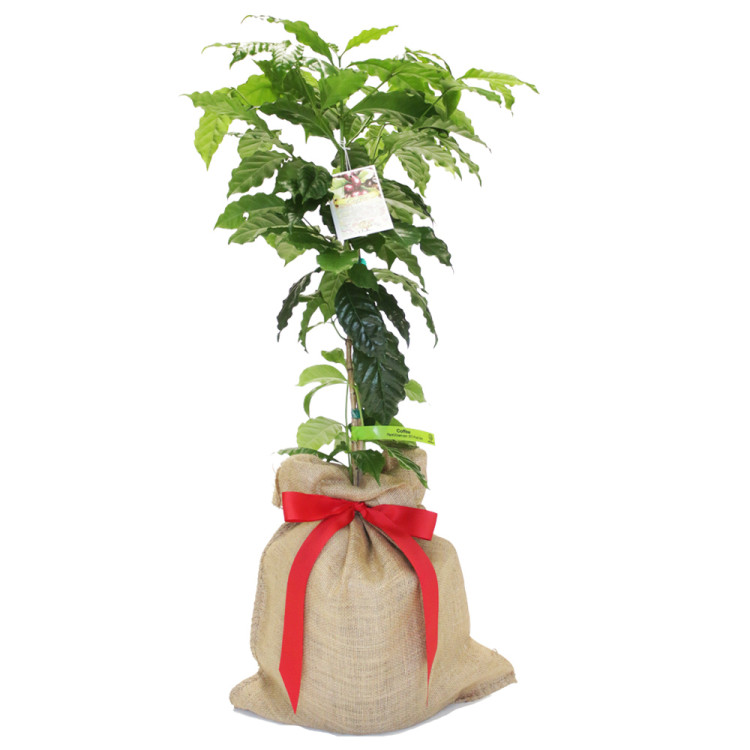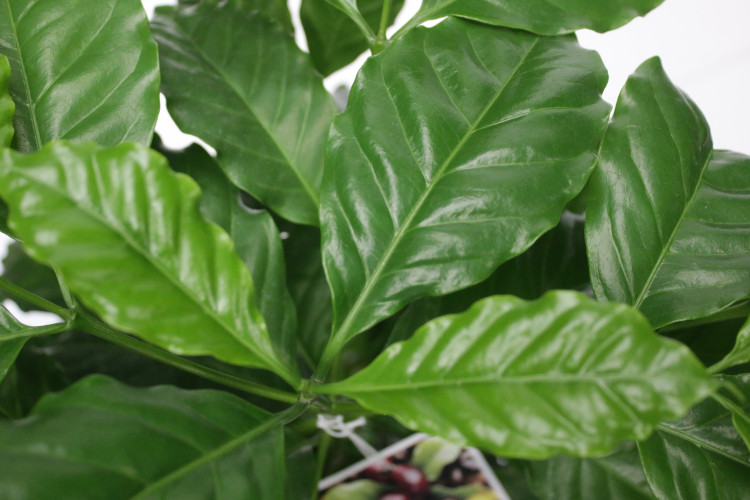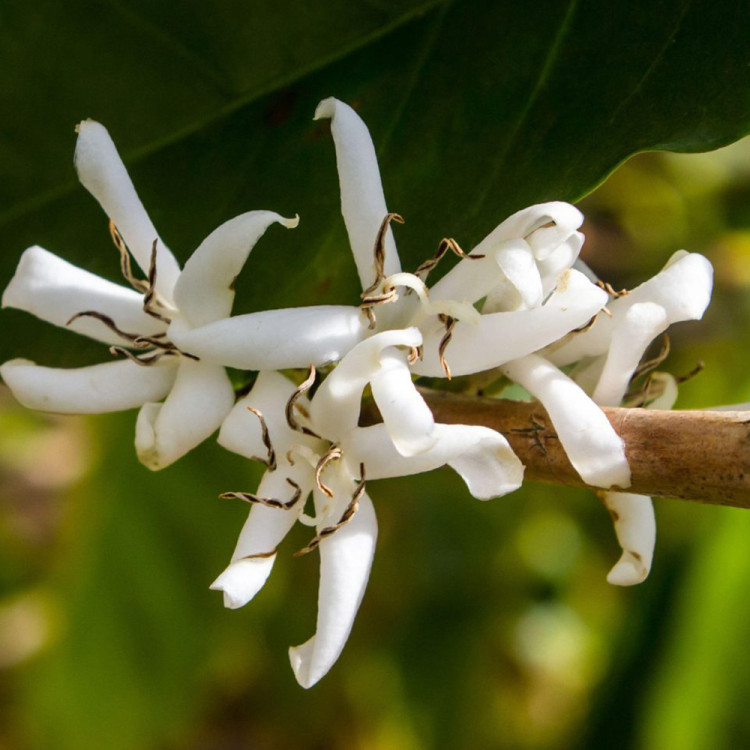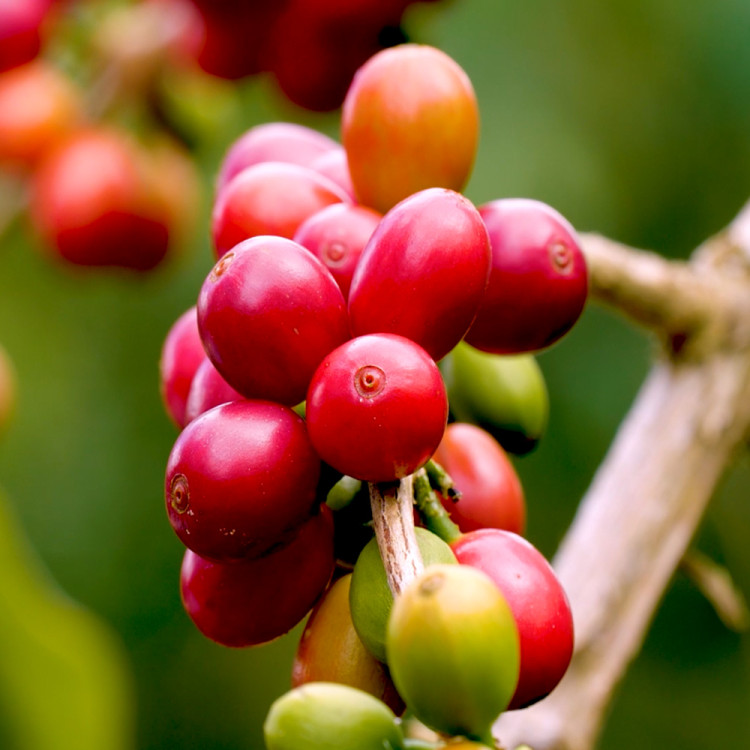- Overview
Common name: Coffee Botanical name: Coffea arabica, C. robusta Family: Rubiaceae Origin: Ethiopia Avg Height X Width: 6' X 4' Season: Winter Damage temp: 28-30 F Coffee Tree in a 3 Gallon Container. Coffee plants have small white, fragrant, star-shaped flowers that are clustered in the leaf axils. They resemble gardenias to which they are related. The edible fruits are small fleshy berries changing in color from green to yellow to red. Two greenish-gray seeds are covered with a thin membrane and are enclosed in a dry husk-like parchment. When only one seed develops it is known as a pea-berry and commands a higher price. The seeds can easily be dried, roasted and ground at home. Coffee plants are fairly easy to grow in the home as a potted specimen, which should be moved outdoors for the summer if possible.
Description
Cultivation
History and Legend
Research
Description
These two species constitute most of the coffee of commerce. The plants are woody, tropical, evergreen shrubs up to 15 feet in height. The leaves are elliptical, glossy, up to 6 inches long and 1/3 as wide. The fruit is a fleshy berry, in which 2 seeds are imbedded. Blossoming and fruit setting occur mainly 2 to 3 times per year. About 6 to 7 months are required to ripen the fruit, so fruits at various stages of maturity are on the plants at the same time. Ripe berries are picked at about 2-week intervals. The pulp is removed by machines. Seeds are dried in the sun or in dehydrators and roasted before being marketed. U.S. production was given as 5,000 tons, 1959 census (Hawaii only). Imports total about 1,450,000 tons annually.
Cultivation
Coffea arabica takes about seven years to mature fully and does best with 1-1.5 meters (about 40-59 inches) of rain, evenly distributed throughout the year. It is usually cultivated between 1,300 and 1,500 m altitude, but there are plantations as low as sea level and as high as 2,800 m. The plant can tolerate low temperatures, but not frost, and it does best when the temperature hovers around 20°C (68°F). Commercial cultivars mostly only grow to about 5 m, and are frequently trimmed as low as 2 m to facilitate harvesting. Unlike Coffea canephora (robusta), Coffea arabica prefers to be grown in light shade. Drawing of Coffea arabicaThree to four years after planting coffea arabica produces small, white and highly fragrant flowers. The sweet fragrance resembles the sweet smell of jasmine flowers. The flowers that open on sunny days produce the greatest numbers of berries. This can be a curse however as coffee plants tend to produce too many berries; this can lead to an inferior harvest and even damage yield in the following years as the plant will favor the ripening of berries to the detriment of its own health. On well kept planatations this is prevented by pruning the tree. The flowers themselves only last a few days leaving behind only the thick dark green leaves. The drupes, or berries, then begin to appear. These are as dark green as the foliage, until they begin to ripen, at first to yellow and then light red and finally darkening to a glossy deep red. At this point they are called 'cherries' and are ready for picking. The berries are oblong and about 1 cm long. Inferior coffee results from picking them too early or too late, so many are picked by hand. But they are sometimes shaken off the tree onto mats. The trees are difficult to cultivate and each tree can produce anywhere from 0.5-5 kg of dried beans, depending on the tree's individual character and the climate that season. The berries themselves are edible. They are very sweet, with a texture somewhat like a grape. The real prize of this cash crop are the beans inside. Each berry holds two locules containing the beans. The coffee beans are actually two seeds within the fruit, there is sometimes a third seed or one seed, a peaberry in the fruits at tips of the branches. These seeds are covered in two membranes, the outer one is called the 'parchment' and the inner one is called the 'silver skin'. In perfect conditions, like those of Java, trees are planted at all times of the year and are harvested year round. In less ideal conditions, like those in parts of Brazil, the trees have a season and are harvested only in winter. Gourmet coffees are almost exclusively high-quality mild varieties of coffea arabica.
History and Legend
According to legend, human cultivation of coffee began after goats in Ethiopia were seen becoming frisky after eating the leaves and fruits of the coffee tree. In reality, human consumption of coffee fruits probably began long before humans took up pastoralism. In Ethiopia there are still some locales where people drink a tisane made from the leaves of the coffee tree. The first written record of coffee, made from roasted coffee beans, comes from Arabian scholars who wrote that it was useful in prolonging their working hours. The Arab innovation of making a brew from roasted beans, spread first among the Egyptians and Turks and later on found its way around the world.
ResearchBrazilian biologists have found an Ethiopian Coffea arabica that naturally contains very little caffeine. Paulo Mazzafera, a researcher of Universidade Estadual de Campinas, recently published findings in the journal Nature about these strains of Coffea arabica plants. While beans of normal Coffea arabica plants contains 12 milligrams of caffeine per gram of dry mass, these newly found mutants contain only 0.76 milligrams of caffeine per gram with all the taste of normal coffee.
- Features
weight: 9.99 lbs : - ReviewsThere is no reviews yet...Be the first!
Be the first to write a review of this product!











